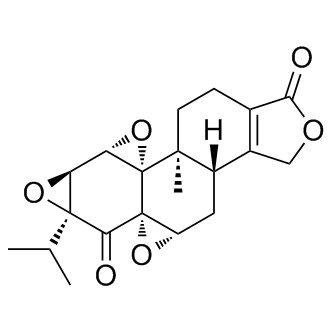
Triptonide
CAS No. 38647-11-9
Triptonide( NSC 165677 | PG 492 )
Catalog No. M14332 CAS No. 38647-11-9
A key bioactive small molecule identified in Tripterygium wilfordii Hook F., has a broad spectrum of biological functions.
Purity : >98% (HPLC)
 COA
COA
 Datasheet
Datasheet
 HNMR
HNMR
 HPLC
HPLC
 MSDS
MSDS
 Handing Instructions
Handing Instructions
| Size | Price / USD | Stock | Quantity |
| 5MG | 104 | In Stock |


|
| 10MG | 152 | In Stock |


|
| 25MG | 267 | In Stock |


|
| 50MG | 471 | In Stock |


|
| 100MG | 683 | In Stock |


|
| 200MG | Get Quote | In Stock |


|
| 500MG | Get Quote | In Stock |


|
| 1G | Get Quote | In Stock |


|
Biological Information
-
Product NameTriptonide
-
NoteResearch use only, not for human use.
-
Brief DescriptionA key bioactive small molecule identified in Tripterygium wilfordii Hook F., has a broad spectrum of biological functions.
-
DescriptionA key bioactive small molecule identified in Tripterygium wilfordii Hook F., has a broad spectrum of biological functions; effectively inhibits canonical Wnt/β-catenin signaling by targeting the downstream C-terminal transcription domain of β-catenin; upregulates the expression of IL-37; potently inhibits the proliferation of human B-lymphoma Raji and T-lymphoma Jurkat cells with IC50 of 5.7 nM and 4.8 nM, respectively.(In Vitro):Triptonide blocks Wnt/β-catenin signaling via C-terminal transactivation domain of β-catenin, and promots apoptosis in Wnt-dependent cancer cells.Triptonide potently inhibits the proliferation of human B-lymphoma Raji and T-lymphoma Jurkat cells with IC50 of 5.7 nM and 4.8 nM, respectively.Triptonide (2.5-10 nM; 6 days) significantly suppresses B-lymphoma cell colony-forming capability.Triptonide (20 nM; 3 days) promotes apoptosis through activation of PARP and caspase 3, but reduction of BCL2 protein levels in the lymphoma cells.Triptonide (5-10 nM; 72 hours) markedly reduces both total and phosphorylated Lyn proteins, and diminishes Lyn downstream ERK and ATK signal pathways.(In Vivo):Triptonide (5 mg/kg; i.p.; daily; for 34 days) exerts a strong anti-lymphoma effect in mice.
-
In VitroTriptonide blocks Wnt/β-catenin signaling via C-terminal transactivation domain of β-catenin, and promots apoptosis in Wnt-dependent cancer cells.Triptonide potently inhibits the proliferation of human B-lymphoma Raji and T-lymphoma Jurkat cells with IC50 of 5.7 nM and 4.8 nM, respectively.Triptonide (2.5-10 nM; 6 days) significantly suppresses B-lymphoma cell colony-forming capability.Triptonide (20 nM; 3 days) promotes apoptosis through activation of PARP and caspase 3, but reduction of BCL2 protein levels in the lymphoma cells.Triptonide (5-10 nM; 72 hours) markedly reduces both total and phosphorylated Lyn proteins, and diminishes Lyn downstream ERK and ATK signal pathways. Cell Proliferation Assay Cell Line:B-lymphoma Raji cells, T-lymphoma Jurkat cells Concentration:0-80 nM Incubation Time:3 days, 6 days Result:Inhibited lymphoma cell tumorigenic capability in a dose-dependent manner.Apoptosis Analysis Cell Line:Raji cells Concentration:5 nM, 10 nM, 20 nM Incubation Time:3 days Result:Did not significantly induce apoptosis at the effective tumor growth-inhibitory (2.5-10 nM); moderately induced lymphoma cell apoptosis (20 nM).Western Blot Analysis Cell Line:Raji cells Concentration:5 nM, 10 nM, 20 nM Incubation Time:3 days Result:Did not vigorously activated pro-apoptotic proteins PARP and caspase 3 in lymphoma cells (5-10 nM); significantly activated PARP and caspase 3 (20 nM); significantly reduced anti-apoptotic BCL2 levels. RT-PCRCell Line:Raji cells Concentration:5 nM, 10 nM Incubation Time:72 hours Result:Significantly diminished Lyn mRNA levels in the lymphoma cells.
-
In VivoTriptonide (5 mg/kg; i.p.; daily; for 34 days) exerts a strong anti-lymphoma effect in mice. Animal Model:Eight-week-old female NOD/SCID mice (18-22 g), with 3 x 107 Raji cells xenograft Dosage:5 mg/kg Administration:Intraperitoneal injection, daily, for 34 days Result:Potently inhibited lymphoma cell growth and tumorigenic capability.
-
SynonymsNSC 165677 | PG 492
-
PathwayWnt/Notch/Hedgehog
-
TargetBeta-catenin
-
RecptorOthers
-
Research AreaCancer
-
Indication——
Chemical Information
-
CAS Number38647-11-9
-
Formula Weight358.3851
-
Molecular FormulaC20H22O6
-
Purity>98% (HPLC)
-
Solubility10 mM in DMSO
-
SMILESO=C1OCC2=C1CC[C@@]3(C)[C@H]2C[C@H]4[C@]5(O4)[C@@]3(O6)[C@@H]6[C@H](O7)[C@@]7(C(C)C)C5=O
-
Chemical NameTrisoxireno[4b,5:6,7:8a,9]phenanthro[1,2-c]furan-1,6(3H,6aH)-dione, 3b,4,4a,7a,7b,8b,9,10-octahydro-8b-methyl-6a-(1-methylethyl)-, (3bS,4aS,5aS,6aS,7aS,7bS,8aS,8bS)-
Shipping & Storage Information
-
Storage(-20℃)
-
ShippingWith Ice Pack
-
Stability≥ 2 years
Reference
1. Chinison J, et al. Sci Rep. 2016 Sep 6;6:32779.
2. He L, et al. Cell Mol Immunol. 2015 Jul;12(4):515-8.
3. Yang P, et al. Toxicol Lett. 2017 Jun 27;278:9-17.
molnova catalog



related products
-
PRI-724
PRI-724 (PRI724)?is a potent, specific, second generation CBP/beta-catenin antagonist with IC50 of 150 nM.
-
CCT-031374
CCT-031374 is a selective β-catenin signaling inhibitor with IC50 of 6.1 uM.
-
KY-1220
KY-1220 is a small molecule destabilizer of both β-catenin and Ras via inhibition of the Wnt/β-catenin pathway (IC50=2.1 uM).



 Cart
Cart
 sales@molnova.com
sales@molnova.com


